in the #YearOfPWA
Maxim Salnikov
@webmaxru
Progressive
Angular Apps


How to create Angular Progressive Web App?
Using the native tools
Maxim Salnikov

-
Google Developer Expert in Angular
-
Angular Oslo / PWA Oslo meetups organizer
-
ngVikings / ngCommunity organizer
Products from the future
UI Engineer at ForgeRock



After all, what is PWA?
Progressive web apps use modern web APIs along with traditional progressive enhancement strategy to create cross-platform web applications.
These apps work everywhere and provide several features that give them the same user experience advantages as native apps.

Cross-platform?
Browser
Desktop
Mobile








Flagged


OS
#YearOfPWA





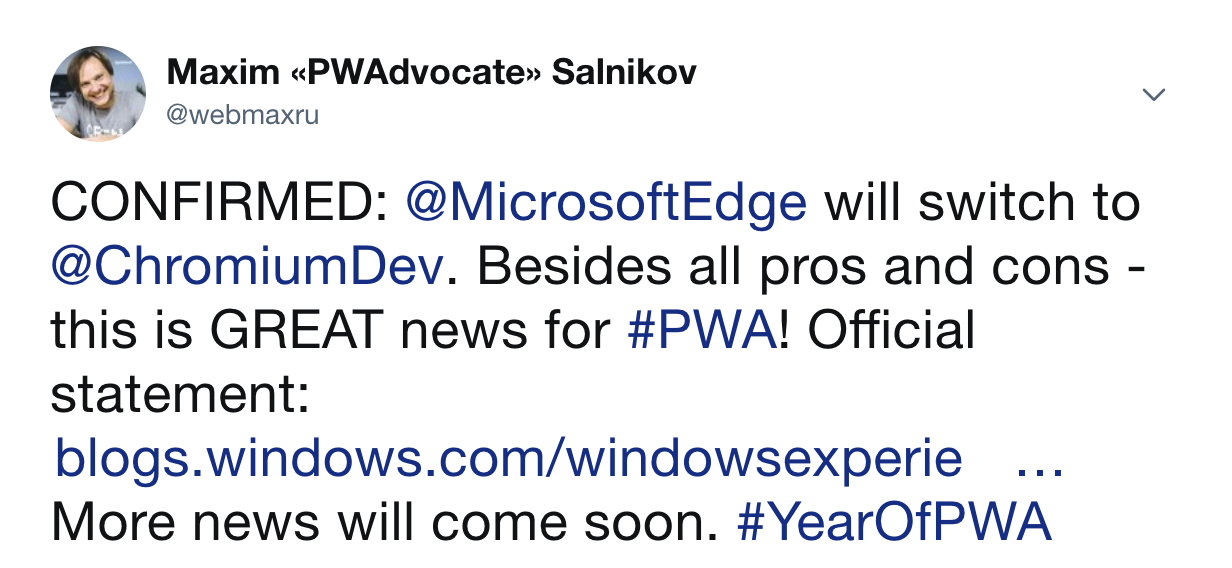

UX advantages?
Smart networking + Offline
Proper app experience
Staying notified
Other cool things
}
Service Worker API
Web App Manifest


Service worker options
-
Code service worker manually
-
Use framework-agnostic PWA libraries
-
Use Angular Service Worker
NGSW
Automate it!


Automation
-
Scaffolding
-
Building
-
Running
1
2
3
Schematics
Angular CLI
NGSW
PWA MVP
Recipe #1
=
+
Application shell
Web App Manifest
Fast, responsive, mobile-first
Served via HTTPS



$ ng add @angular/pwaApply PWA schematics
1
-
Add service worker registration code to the root module
-
Generate default service worker configuration file
-
Generate and link default Web App Manifest
-
Generate default icons set
-
Enable build support in Angular CLI config
$ ng build --prodBuild
ngsw-worker.js
ngsw.json
dist/project-name
safety-worker.js
assets/icons/*.png
manifest.json
worker-basic.min.js
2
Running and auditing
$ ng serveStatic dev webserver
-
serve
-
superstatic
-
lite-server
$ ng serve --prod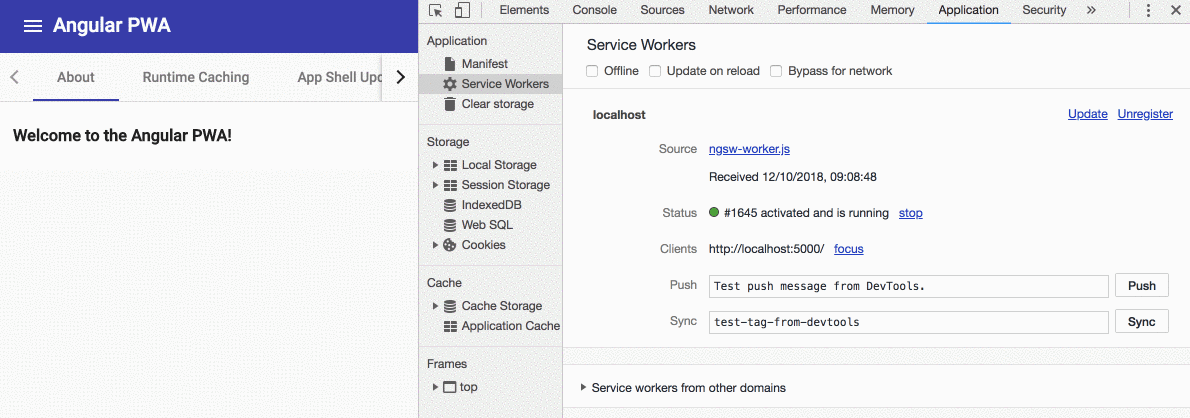
Dev Tools / Audit / PWA
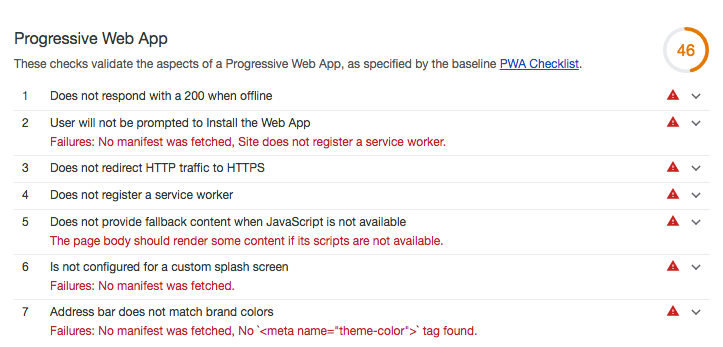
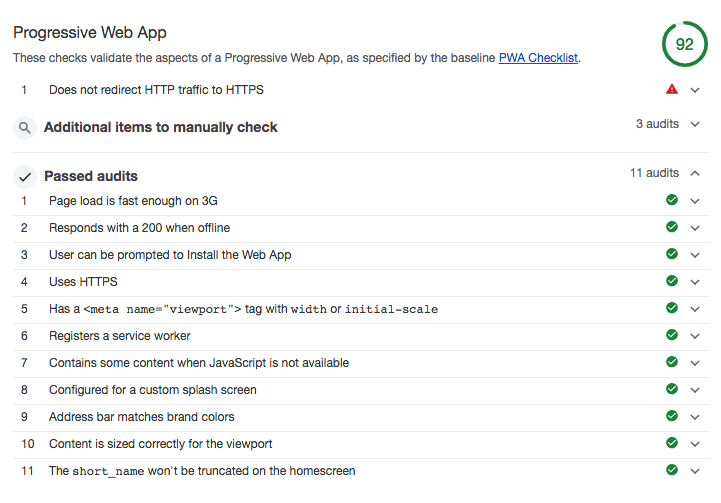
Automated app shell actions
-
Generate assets (+ hashes) list
2
3
-
Load and cache assets
-
Set up routing
-
Serve assets from the Cache Storage
-
Load and cache the updated assets
-
Inform the application about the update (next recipe)
NGSW configuration file
ngsw-config.json
{
"index": "/index.html",
"assetGroups": [...],
"dataGroups": [...]
}App shell
assetGroups
{
"name": "app",
"installMode": "prefetch",
"resources": {...}
}App shell resources
assetGroups / "app" / resources
"resources": {
} "files": [
"/favicon.ico",
"/index.html",
"/*.css",
"/*.js"
]App update notification
Recipe #2
App version updates
v1
v2
v1
v1
v2
Deployed
Displayed
v2


A new version of the app is available. Click to refresh.
Using SwUpdate service
import { SwUpdate } from '@angular/service-worker';
constructor(updates: SwUpdate) {}this.updates.available.subscribe(event => {
})updates.component.ts
if (confirm(`New Version is available! OK to refresh`)) {
window.location.reload();
}Hint: Provide a version description
{
"appData": {
"versionMessage": "New version: Push notifications added!"
},
...
}let message = event.available.appData['versionMessage']
if (confirm(message)) {...}ngsw-config.json
updates.component.ts
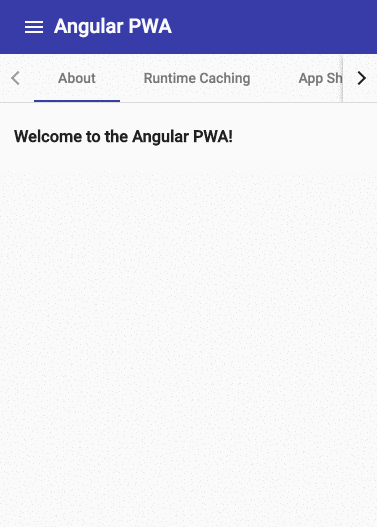
Adding more resources to the App Shell
Recipe #3
App shell / on-demand
assetGroups
{
"name": "assets",
"installMode": "lazy",
"updateMode": "prefetch",
"resources": {...}
}App shell / on-demand
assetGroups / "assets" / resources
"resources": {
} "files": [
"/assets/**"
], "urls": [
"https://fonts.googleapis.com/**",
"https://fonts.gstatic.com/**"
]Removing routes from NGSW control
Recipe #4
ngsw-config.json
"navigationUrls": [
'/**',
'!/**/*.*',
'!/**/*__*',
'!/**/*__*/**',
] '!/**/login*',
'!/**/account*'What to redirect to index.html
Data requests caching
Recipe #5
Runtime caching
dataGroups
{
"name": "api-freshness",
"urls": [
"/api/breakingnews/**"
],
} "cacheConfig": {
"strategy": "freshness",
"maxSize": 10,
"maxAge": "12h",
"timeout": "10s"
}Runtime caching
dataGroups
{
"name": "api-performance",
"urls": [
"/api/archive/**"
],
} "cacheConfig": {
"strategy": "performance",
"maxSize": 100,
"maxAge": "365d"
}Hint: Support API versioning
dataGroups
{
"version": 1,
"name": "api-performance",
"urls": [
"/api/**"
],
...
}{
"version": 2,
"name": "api-performance",
"urls": [
"/api/**"
],
...
}Subscribing for the Push notifications
Recipe #6
Push notifications
import { SwPush } from '@angular/service-worker';
constructor(push: SwPush) {}subscribeToPush() {
this.push.requestSubscription({
serverPublicKey: this.VAPID_PUBLIC_KEY
})
.then(pushSubscription => {
// Pass subscription object to the backend
})
}push.component.ts
Push notifications / send
{
"notification": {
}
}server-side.js / sendNotification payload
"title": "Very important notification",
"body": "Angular Service Worker is cool!",
"icon": "https://angular.io/assets/logo.png",
"actions": [
{
"action": "gocheck",
"title": "Go and check"
}
],
...In case of emergency
Recipe #7
Last resort
cp safety-worker.js ngsw-worker.jsself.addEventListener('install', e => { self.skipWaiting(); });
self.addEventListener('activate', e => {
e.waitUntil(self.clients.claim());
self.registration.unregister().then(
() => { console.log('Unregistered old service worker'); });
});safety-worker.js
A gentle way
rm ngsw.jsonDisadvantages
-
Angular Service Worker always works as the main service worker of the whole application
-
There is no [documented] way to extend the functionality
Advantages
-
Minimal PWA goes out-of-the-box
-
Essential features are codeless
-
Doing things in Angular way
-
Advanced integrity checks + fallback support
-
1800+ developers
-
Major browsers/frameworks/libs reps
Thank you!
Maxim Salnikov
@webmaxru